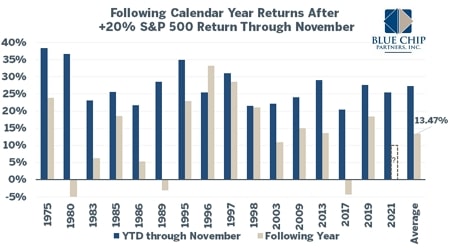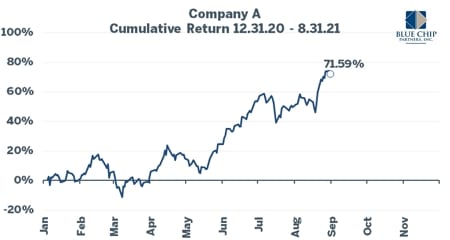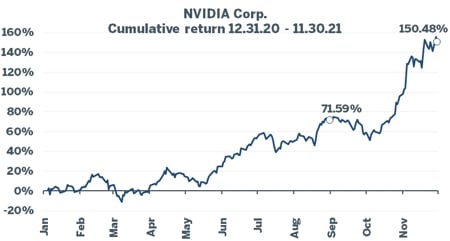What Goes Up Must Come Down
As inferred from Sir Isaac Newton’s third law of motion, the natural tendency of many of our clients is to ask one burning question:
“When is the market going to take a turn for the worse?”
While we will be the first to admit that we are not experts in the field of physics, we are students of the market, and we are students of history. Our investment management philosophy is grounded in historical data, and as financial markets evolve, so does our investment process and base of investment offerings. Worth noting is the simple observation that while history does not repeat itself, it often rhymes.
So, to answer that burning question, we start with the past. While the investment committee at Blue Chip Partners spends the majority of its time looking forward, checking the rear-view mirror can uncover insight that may be contrary to broad expectations, or laws of physics for that matter.
Year-to-date (YTD) through the end of November, the S&P 500 Index has appreciated 23.2%. This performance comes on the back of a tumultuous 2020 which saw the S&P rise 18.4% despite meaningful hurdles. Given the run, the knee-jerk question regarding a market downturn is natural. However, based on empirical evidence, strong performance over a period of time does not necessitate imminent doom. Since 1975, there have been 15 years in which the S&P 500 returned >20% YTD through the end of November. In the calendar years that immediately followed, 3 showed negative results and 12 displayed positive returns for an overall average of 13.5%.

While another year of 20%+ returns in 2022 is unlikely, historical data reveals that strong years don’t have to be followed by disappointing ones. Just as many apply the “what goes up must come down” mentality to broad markets, the same can be seen in sentiment at the company-level.
Take Company A for example, shown below. Company A contributes to the creation of a good, operates in a cyclical industry, and experienced significant demand for its products coming out of the pandemic.

After the stock grew 71.6% YTD through the end of August, a common reaction was the expectation for mean reversion. More specifically:
- “Shares are richly valued after such a run.”
- “Demand is high coming out of a disrupted period, but surely the company will soon be impacted by the cyclical nature of their industry.”
- “Supply chain troubles will catch up to them.”
Company A is NVIDIA* Corp. From the end of August to the end of November alone, the company returned 46.0%, resulting in a full period return of 150.5%.

Just because things have been good doesn’t imply that they cannot improve further. While we fully acknowledge the looming risks that include persistent inflationary pressure, continued supply chain disruptions, and a transition in monetary policy, it is important to note that the gains we have seen are not unfounded:
For S&P 500 companies, year-over-year revenue growth and profit margins remain close to record levels.
56 firms in the index provided positive earnings guidance for the coming quarter (the 4th highest number since 2006).
For NVIDIA, 50% top line growth in Q3 relative to the same period last year equates to the 7th largest company in the U.S. growing at rates that are consistent with those hunting for series A funding (an early-stage startup).
So, must everything that has gone up eventually come down?
Markets certainly take a breath from time to time, which can be healthy for long-term advancement. However, the impact of past market appreciation on future returns is not linear. When I hit a golf ball, I may not know where it is going, but I know it will come down somewhere. As investors, we are fortunate that financial markets do not abide by the laws of physics.
Data Source: Bloomberg, as of November 30, 2021
*NVIDIA Corporation is not a current model position at Blue Chip Partners
Expressions of opinion are as of this date and are subject to change without notice. The information provided does not constitute tax, legal, accounting, or other professional advice and is without warranty as to the accuracy or completeness of the information. Any information provided is not a complete summary or statement of all available data necessary for making an investment decision and does not constitute a recommendation to buy, hold or sell any security. The information has been obtained from sources considered to be reliable, but we do not guarantee that the foregoing material is accurate or complete. There are limitations associated with the use of any method of securities analysis. Indices are included for informational purposes only; investors cannot invest directly in any index. Every investor’s situation is unique, and you should consider your investment goals, risk tolerance and time horizon before making any investment. Prior to making an investment decision, please consult with your financial advisor about your individual situation. Past performance does not guarantee future results. Investing involves risk and you may incur a profit or loss regardless of strategy selected. There is no guarantee that any statements, opinions or forecasts provided herein will prove to be correct.

